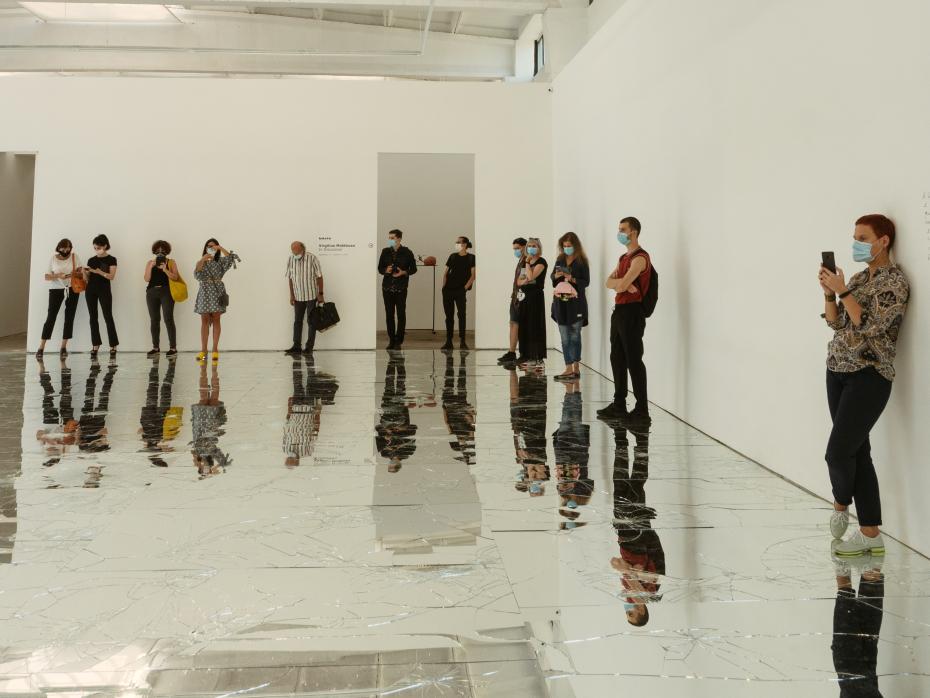
Singing on mute: facilitating practical creative work online

What do you do when you teach a practical subject and no face-to-face teaching is allowed? At first, teaching practical classroom musicianship to trainee music teachers online seemed unfeasible. There are two technical problems that prevent musicians from being able to play and sing together live online. First is latency, the short delay between a person making a sound or action in a video call and another person hearing and seeing it. The second is that microphones and speakers on headphones and computers will only process audio in or out, so you can either make a sound or hear a sound – but not both together. These technical limitations make coordinating any live performance in online streaming practically impossible.
I was determined to create an immersive and creative online learning experience for my students. I decided to be inventive with the resources at my disposal and focus on what the technology could do to facilitate practical work, rather than dwelling on what was not possible.
1. Leave no one behind
It’s really important that students have the resources they need to complete practical work at home and are not disadvantaged because they are off campus. Search for free software, downloads and apps that students can use to complete their practical work. I use a combination of online instruments and free software for score writing and recording. Give some time to making sure that everyone knows how to use the resources. Start your module with an orientation session, with some quick and easy activities and games to check that students can find and use these online resources.
2. Let’s get physical
Physical movement combats the lethargy of sedentary online learning. I start every session with a physical warm-up as a grabber to engage mind and body, develop hand-eye coordination and develop aural memory, all essential musical skills. Our warm-ups include chants, singing and rhythm games with body percussion, and props such as chopsticks and cups. I recommend the National Youth Choir of Scotland’s Learn at Home resource if you want to try these yourself. Other physical starters could include memory games or picture quizzes. A snappy start to the session energises the students and showcases practical learning in your teaching.
3. Singing on mute
Look for ways that students can talk in online live sessions, so that yours is not the only voice heard. When students speak on mic, they feel invested in the learning and develop strong social connections with their classmates. Hearing students’ work is an opportunity for formative assessment. I ask students to play and sing throughout practical sessions with their mics muted, and then unmute to hear individuals’ work. I can spot-check a student’s understanding and share the work of individuals with the whole group. With larger groups, elect a spokesperson to report back to the whole class after students have been in breakout rooms, and rotate this responsibility among the group so that the maximum number of students have a chance to speak.
4. Must, should, could
It’s great to check in with students one at a time, but not if it slows up the pace of the whole class. Practical tasks can be differentiated when students are working on mute so everyone stays busy. I devise practical tasks with three levels of challenge: what students must do, what they should be able to do, and what they could do to push themselves further – mixing up consolidation, problem-solving and fluency practice tasks at all levels.
5. Short and snappy
My musicianship workshops used to be timetabled in three-hour blocks, but live online teaching needs to be kept short to avoid screen fatigue. Sandwich longer sessions of offline work that requires thinking time between shorter live online taught sessions. For me, 60 minutes is ideal for live online teaching. Encourage students to share their practical work for informed critical peer review as part of the asynchronous component of your module so they continue to progress between the live taught sessions, and your live teaching supports their practical skills development.
There are many ways to facilitate students in practical work online. Focus on what the technology can do, rather than what it can’t, and you will find ways to nurture practical work in your teaching in both live and asynchronous online learning.
Rebecca Berkley is associate professor in music education, Institute of Education, University of Reading.
If you’d like advice and insight from academics and university staff delivered direct to your inbox each week, sign up for the Campus newsletter.


